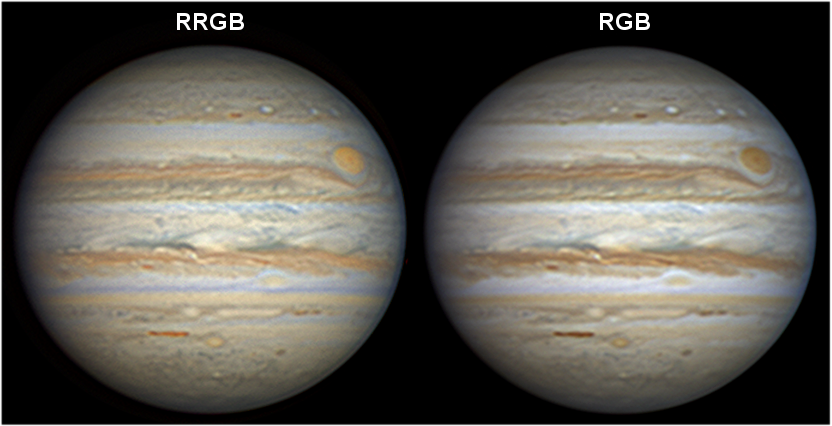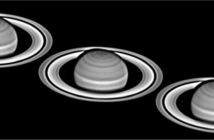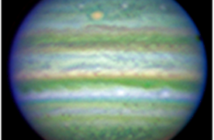After reviewing why it is better to use a true green filter for planetary imaging, I’m now talking about the use of luminances realized with mono-band filters, in particular with red or infrared images. If you appreciate this kind of processing this is fine, but just keep in mind that scientific analysis of planetary images requires “true-color” imaging. Here is why…
Biased colors
This is the first problem of RRGB or IRRGB processing. To correctly reproduce colors, the LRGB method of planetary imaging supposes that the the relative albedo of details on both the luminance and chrominance is identical. This means that they both must cover the same part of the light spectrum. But this is not the case with luminances obtained from one color band only. Applying a red or infrared luminance on a RGB will change colors sometimes quite a lot, since the equilibrium of albedo is not respected:
Does it really matter, after all? Well color is a physical data that could be objectively measured by calculating the coefficient of reflected sunlight for any details at every wavelength. Color, then, can be described as a code that matters for understanding images: physical changes on the planets translate themselves into color changes as well as shape changes for example. Using a processing that subjectively transforms colors such as RRGB do not allow such a study to be carried out anymore. On the above RRGB image of Jupiter, it’s clear that the tint of the red spots is not correct; the NNTZ LRS has almost the same color as the NNTB, while in RGB it has a deeper orange hue that is peculiar to the red spots class of object. On many RRGB images I have seen recently the color of the new “Red oval Z” is sometimes very pale, while its current objective changes of tint does really matter to follow its recent major change.
Inappropriate color processing can even lead to erroneous conclusions. For example if the Martian atmosphere is really dusty, using a red or infrared luminance will artificially enhance the dark surface markings and we might wrongly conclude that the storm has dissipated while it’s not. The case can happen in particular during the decay phase of big storms, when no dust clouds is active anymore but when there is still much dust flying in the air.
Details that disappear
With the LRGB method, the information relative to details is mostly found on the luminance. But a red luminance includes only one third of the whole information contained in visible light. An infrared luminance will mainly change contrasts, but it will make disappear some details that simply do not exist in IR because the information is not the same…
At right is an IR-RGB processing of Jupiter vs. RGB. Apart of the differences of colors, an important detail has completely disappeared ! Red arrows point a “barge”, a cyclonic structure of the North equatorial belt (NEB). They are kind of superficial “holes” in the upper clouds of the NEB and with a few exceptions, they are not visible in infrared… so an IR luminance logically masks it on the final image.
This problem can be visible on every planet, but Mars is one that will especially suffer from it. Wile imaging of surface details is the most popular kind of observations among amateurs, the most interesting is… cloud activity. Mars has a quite dynamical atmospheric activity; in particular, white cloud activity is almost entirely visible in blue light, red and infrared filters do not show it. Processing Mars in RGB or IR-RGB most regrettably wipes out its atmosphere…
Losing resolution…
One advantage frequently quoted of red/IR luminances is the increase of resolution. Yet the resolving power of your telescope is in reality less good in red wavelengths than in green and blue. So it will be true only if seeing is not good or if the telescope presents any optical problems that prevents it from making sharp blue images – so it is not a normal situation. Under good conditions, as for the Mars images above, the RGB is noticeably more resolved. It shows more details (fine cloud details over the Tharsis volcanoes), and far more varied colors on the ground, because it involves the whole spectrum of information and do not limit it to just one color band.






